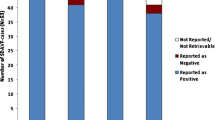Abstract
Background
Spinal arteriovenous malformations (AVM) are rare lesions. They may present with intramedullary hemorrhage or edema, often inducing severe neurological deficits. Active treatment of spinal AVMs is challenging even for experienced neurosurgeons.
Method
Anticipation of anatomy and AVM angiocharacteristics from preoperative imaging is key for successful treatment. Information gathered from MRI and DSA has to be then matched to intraoperative findings. This is a prerequisite for reasonably safe and structured lesion removal.
Conclusion
We provide a structured approach for surgical treatment of spinal AVMs, supplemented by high-resolution video and imaging material.



Similar content being viewed by others
Abbreviations
- ASA:
-
Anterior spinal artery
- AVM:
-
Arteriovenous malformation
- CSF:
-
Cerebrospinal fluid
- EVT:
-
Endovascular treatment
- ICG:
-
Indocyanine green
- LMWH:
-
Low molecular weight heparin
- PSA:
-
Posterior spinal arteries
References
Brinjikji W, Lanzino G (2017) Endovascular treatment of spinal arteriovenous malformations. Handb Clin Neurol 143:161–174
Ehresman J, Catapano JS, Baranoski JF, Jadhav AP, Ducruet AF, Albuquerque FC (2022) Treatment of spinal arteriovenous malformation and fistula. Neurosurg Clin N Am 33(2):193–206
Gross BA, Du R (2013) Spinal glomus (type II) arteriovenous malformations: a pooled analysis of hemorrhage risk and results of intervention. Neurosurgery 72(1):25–32
Kim LJ, Spetzler RF (2006) Classification and surgical management of spinal arteriovenous lesions: arteriovenous fistulae and arteriovenous malformations. Neurosurgery 59(5 Suppl 3):S195–S201
Lasjaunias P (2003) Spinal cord vascular lesions. J Neurosurg 98(1 Suppl):117–119
McGirt MJ, Garcés-Ambrossi GL, Parker SL, Sciubba DM, Bydon A, Wolinksy J-P, Gokaslan ZL, Jallo G, Witham TF (2010) Short-term progressive spinal deformity following laminoplasty versus laminectomy for resection of intradural spinal tumors: analysis of 238 patients. Neurosurgery 66(5):1005–1012
Mizutani K, Consoli A, Maria FD, Condette Auliac S, Boulin A, Coskun O, Gratieux J, Rodesch G (2021) Intradural spinal cord arteriovenous shunts in a personal series of 210 patients: novel classification with emphasis on anatomical disposition and angioarchitectonic distribution, related to spinal cord histogenetic units. J Neurosurg Spine 2:1–11. https://doi.org/10.3171/2020.9.SPINE201258
Santillan A, Nacarino V, Greenberg E, Riina HA, Gobin YP, Patsalides A (2012) Vascular anatomy of the spinal cord. J Neurointerv Surg 4(1):67–74
Spetzler RF, Detwiler PW, Riina HA, Porter RW (2002) Modified classification of spinal cord vascular lesions. J Neurosurg 96(2 Suppl):145–156
Zhan PL, Jahromi BS, Kruser TJ, Potts MB (2019) Stereotactic radiosurgery and fractionated radiotherapy for spinal arteriovenous malformations - a systematic review of the literature. J Clin Neurosci 62:83–87
Key points
1. If a vascular malformation of the spinal cord is suspected, at least MRI and DSA should be performed to confirm the diagnosis.
2. The key to treatment is to understand preoperative MRI and DSA images outlining the anatomy and angioarchitecture of the AVM.
3. Based on images, neurological exam and patient characteristics, decide whether to treat and if surgery is the correct modality.
4. After the dura has been opened, the first step is to find and recognize pre-identified angiographical structures in situ, by inspection and ICG-angiography.
5. Take sufficient time to understand the anatomy: What is part of the nidus and needs to be taken out and what is not part of the pathology and needs to be preserved?
6. Take down major feeders first to reduce the bleeding risk and ease AVM dissection, then subsequently close other feeders.
7. Dural closure should be watertight, laminoplasty may be preferable to laminectomy.
8. Start mobilization and physiotherapy immediately postoperatively, followed by neurorehabilitation.
9. Preexisting neurological deficits may be (transiently) worsened after surgery and only long-term follow-up will show the final result of the treatment.
10. We advocate performing DSA after surgery and MRI after 3 to 6 months, to verify AVM obliteration and regression of edema.
Author information
Authors and Affiliations
Contributions
All authors contributed to the study conception and design. Material preparation, data collection, and analysis were performed by Tobias Rossmann, Michael Veldeman, and Rahul Raj. The first draft of the manuscript was written by Tobias Rossmann, and all authors commented on previous versions of the manuscript. All authors read and approved the final manuscript.
Corresponding author
Ethics declarations
Ethics approval
The research project was conducted following the principles outlined in the Declaration of Helsinki. Anonymized presentation of a single case does not require an ethics approval by the local university hospital review board.
Informed consent
The patient provided written informed consent for the use of imaging data and operative video.
Conflict of interest
The authors declare no competing interests.
Additional information
Publisher’s note
Springer Nature remains neutral with regard to jurisdictional claims in published maps and institutional affiliations.
This study has not been presented previously.
Supplementary information
ESM 1
Rights and permissions
Springer Nature or its licensor (e.g. a society or other partner) holds exclusive rights to this article under a publishing agreement with the author(s) or other rightsholder(s); author self-archiving of the accepted manuscript version of this article is solely governed by the terms of such publishing agreement and applicable law.
About this article
Cite this article
Rossmann, T., Veldeman, M., Raj, R. et al. How I do it: surgery for spinal arteriovenous malformations. Acta Neurochir 165, 1447–1451 (2023). https://doi.org/10.1007/s00701-023-05598-3
Received:
Accepted:
Published:
Issue Date:
DOI: https://doi.org/10.1007/s00701-023-05598-3




